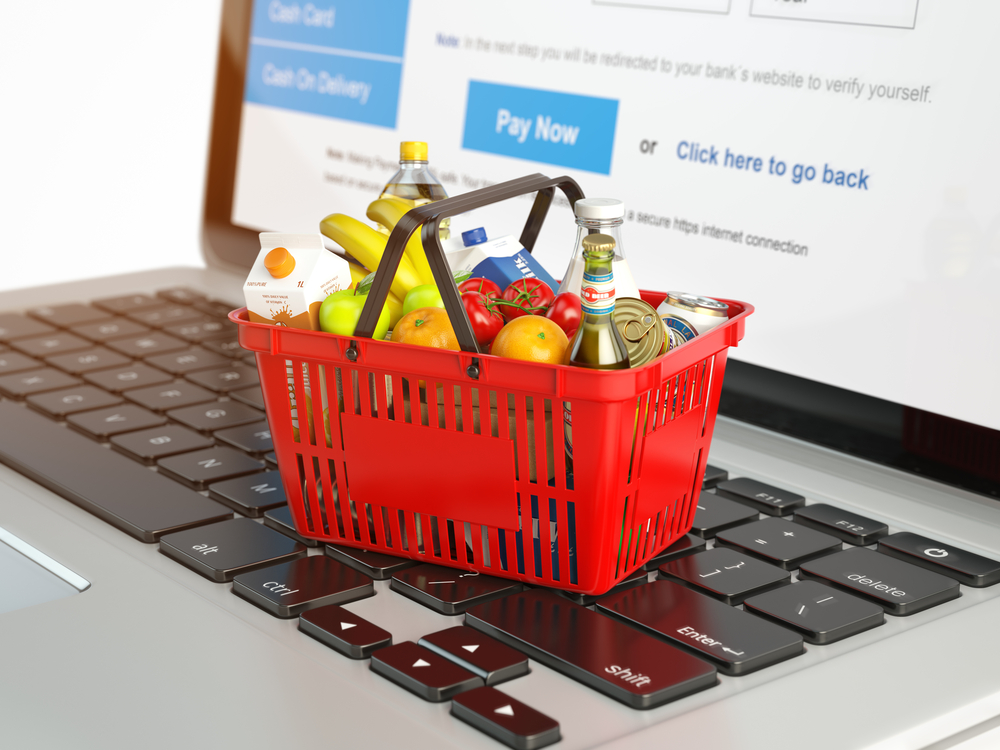The pandemic forced the hand of many U.S. consumers, who turned to virtual shopping carts instead of strolling the aisles of their local grocery stores. For the retail food industry, that translated to a dramatic increase – a 54% uptick – in online grocery orders placed through digital apps and grocery websites in 2020 for home delivery or curbside pickup. January 2021 saw online grocery receipts total $9.3 billion, and estimates place total online grocery sales for this year at $112.9 billion.
Before the pandemic, the grocery industry didn’t anticipate hitting $100 billion in online sales until 2022, yet grocery retailers were already invested in improving digital technology and fulfillment processes for the expected long-term growth in online sales. By 2025, ecommerce will account for 21.5% of all U.S. grocery sales.
Online Grocery Brands Prioritize Convenience & Consumer Loyalty

According to a recent study by Mercatus, an independent research firm, 66% of shoppers say product availability and real-time inventory are very important, both of which can impact brand loyalty. Progressive Grocer notes that traditional grocery stores do have a leg up in loyalty: “Compared to brick-and-mortar [grocery stores], there is far less loyalty for pure-play online retailers, with only 8% of shoppers switching to an online-only operator such as Amazon.” The report indicated that while “traditional drivers preferences (proximity/location, value, product quality and convenience) have not changed during the pandemic,” 56% of shoppers say lack of product availability drove them to look outside of their preferred brick-and-mortar grocery stores, and as many as 40% of shoppers shifted to “other online shopping options” for reliability.
Mercatus president and CEO Sylvain Perrier says chain grocers can’t rely on offline brand loyalty alone. “The growth of online grocery in 2020 and its predicted long-term impact, coupled with customers’ continued loyalty to brick and mortar, makes it clear that these avenues [brick-and-mortar and online grocery stores] must complement each other in creating a great customer experience across a grocer’s entire brand.” Perrier recommends making investments “in digital functionality, especially regarding product search, discovery and product information.”
Target is positioning itself to be “America’s Easiest Place to Shop,” touting one-stop conveniences. And, with continued investments in technology, Target’s digital channel drove nearly $10 billion in growth during 2020, with much of that attributed to same-day pickup and delivery options.
As for online dominance, many are watching Instacart, which is estimated to hold 50% of the online grocery market now following explosive growth during the pandemic. Almost overnight, they saw 500% growth in order volume, fulfilling orders from more than 40,000 retail store locations in North America. And Instacart is continuing to work with grocery and convenience store chains to improve the overall customer experience for delivery services driven by online purchasing.
Traditional Grocery Stores Continue To Optimize Subscription Plans
Top supermarket chains are using recurring subscription models to drive increased loyalty and revenue. By charging an annual fee or low-monthly cost for the convenience of unlimited pickups or home delivery, chains like Giant are banking on adding new loyal customers. Giant’s new Choice Pass program is designed to drive more value for frequent shoppers, while keeping them financially committed to the loyalty program. Perks such as special offers and personalized rewards incentivize higher-dollar virtual shopping carts with the promise of “more savings with the more you order” — a natural shift from in-store promotions such as bulk item savings.
Subscription models will force the major chains offering them — including Hy-Vee, Kroger, Albertsons and Walmart — to be competitive on membership fee pricing and associated value.
Convenience Stores Turn To Digital Strategies Amid Growing Sales Of Grocery Items
Watching the success of their grocery store peers, the convenience store (c-store) industry saw an opportunity to grow revenues from their existing customer base, which typically serves half of the U.S. population on a daily basis. NACS, the trade association for c-stores, says 52% of their retailers have seen increased grocery sales during the pandemic, and have responded by adding more cleaning and toiletry products and ready-to-eat meals and by showcasing multipack and bulk items to compete with traditional grocery retailers. To boost convenience further, c-stores are expanding order options, including mobile- and app-based options with delivery and a variety of in-store and at-store pickup options.
The robust return of in-person shopping is going to be a test for all verticals that pivoted to digital solutions and ecommerce shopping because of the pandemic. For grocery stores in particular, the lessons of the last year, that people are interested and willing to shop for groceries online when availability, convenience and cost meet their needs, will be carried into the future with grocery brands likely turning to a hybrid of successful digital strategies complemented by in-person shopping. By continuing to optimize digital strategies that are effective, grocery brands can stay in front of consumers, sharing new products, services and promotions, driving conversions online and in store.
Seeking New Ways To Maximize Your Customer Acquisition?
Digital Media Solutions (DMS) is a technology-enabled, data-driven performance advertising solutions provider connecting consumers and advertisers. Contact DMS today to learn how our first-party data asset, proprietary technology and expansive digital media reach can help you scale your customer acquisition results.



